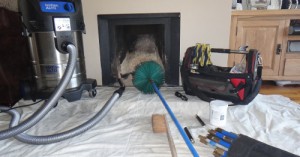Chimney Cleaning Tools
This winter has been a rough one, and when it finally comes to an end, all fireplace users will be in dire need of a chimney cleaning. During your annual inspection, a chimney sweep will be able to tell you if a cleaning is necessary. This is typically any time soot has built up to at least 1/8″ thick. When they remove soot, creosote, and other chemicals that have managed to build up inside your fireplace and flue, specific cleaning equipment will come in handy.
Brushes
- Wire Brush – Flat, round brushes that are able to squeeze into tight spaces in order to remove soot and creosote from the inside walls of the chimney. If allowed to accumulate for a while, creosote can turn into a glaze-like material that is hard to remove. However, the wire brush is able to loosen the debris. Wire brushes are sometimes specifically recommended for homeowners that have masonry chimneys with clay flues.
- Polypropylene Brush – An alternative to the wire brush, and a better option for a chimney with a stainless steel liner since the brush will not damage it.
- Hand Brush – A brush with a short handle for cleaning the easy to access areas of the chimney. Similar to a broom, a hand brush allows a chimney sweep to clean the ash and other dusty residue that resides inside the fireplace. This is also a handy tool for using to access tight spaces that a larger brush would not be able to clean.
Rods
Brushes must be paired with rods of appropriate length. A rod is attached to the brush and enables the chimney sweep to maneuver it the full length of the chimney. Rods are available in numerous sizes and are capable of being attached to one another.
Ladder
An obvious tool that every chimney sweep requires is a ladder. The chimney will at times have to be accessed from the top and climbing onto the roof is a necessity.
Shop Vacuum
All chimney sweeps require a vacuum. Some will use a high-velocity vacuum such as a ROVAC that is equipped with HEPA filters. This helps to ensure that the home remains spotless, and the air clean as chimney sweep sucks out all of the remaining soot, ash, and other particles.
Tarps, Covers, and Duct Tape
A good chimney sweep will not come into your home without fireplace covers and floor tarps. They will want your home to be in the same condition as when they arrived. This does not include leaving a sooty mess behind so they will use these tools to keep everything in order.
Goggles and a Mask
Anyone attempting to clean a chimney should be equipped with goggles and a mask for their own protection. Breathing in all of the nasty stuff that accumulates in a chimney is not good for your lungs nor is getting any of it your eyes.
Metal Bucket
A chimney sweep should come with a metal bucket in tow to safely deposit any ash residue that currently exists in the fireplace. A metal bucket is the safest place for ashes to go in case they are not completely out to avoid catching any part of the home on fire.
Chemical Cleaners
When brushes are not fully up to the task of removing all of the debris inside a chimney, chemical cleaners are necessary.
Resources: High’s Chimney Service, howstuffworks, Sweepy Stories, Image via The Soot Doctor
Read for More Information:
- The Importance of Chimney Cleaning
- Chimney Cleaning Improves Air Quality
- Do You Need a Chimney Cleaning?
Wells & Sons Chimney Service offers chimney cleaning and chimney repair in addition to selling and installing wood and gas stoves to the Reading, West Chester, Allentown, Gilbertsville, Boyertown, and surrounding areas in Southeastern Pennsylvania.









